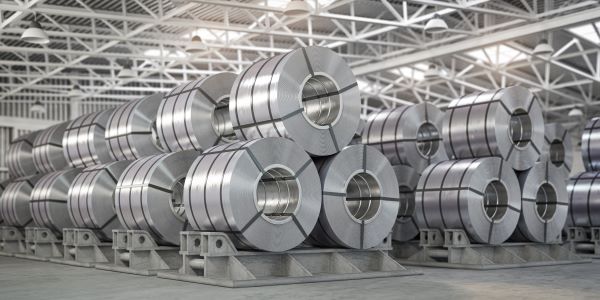What is the Difference Between Ferrous & Non-Ferrous Metals?
While different types of metal can have vastly different properties, they all fall into two general groups: ferrous and non-ferrous. The key and easiest-to-remember difference between the two is that ferrous metals contain iron and non-ferrous metals do not. The history of how these metals have been used goes back to ancient times when the discovery of non-ferrous copper put an end to the Stone Age. Then, thousands of years later around 1200 B.C.E., the expanding applications of ferrous metals brought the world into the Iron Age. Today, both ferrous and non-ferrous metals have numerous applications across nearly every industry.
Ferrous Metals
In addition to containing iron, ferrous metals commonly share two other key properties—magnetism and a vulnerability to rust. They are often used in industrial applications.
Here are some examples of ferrous metals:
Stainless Steel
Stainless steel is one of the strongest ferrous metals and can effectively resist heat and corrosion. It is extremely durable, easily repairable, and can outlast other types of steel.
Wrought Iron
Another durable metal within the ferrous family is wrought iron, an alloy that contains very little carbon and offers excellent fatigue strength. It is commonly used in chains and railings.
Cast Iron
Containing more carbon than wrought iron, cast iron is a strong but brittle ferrous metal. It is often used in automotive parts, such as cylinder heads and gearboxes, as well as utility hole covers.
Carbon Steel
Thanks to its carbon content, carbon steel is one of the hardest ferrous metals. It is used in machinery and power tools, including drill bits and saw blades.
Non-Ferrous Metals
The absence of iron in non-ferrous metals gives them a distinct advantage over their ferrous counterparts: They are less prone to rust and corrosion. Additionally, they are softer and can be more easily shaped. Because of this, they are often used in rain gutter systems, liquid-carrying pipes, and other applications where they’re exposed to moisture.
Non-ferrous metals include:
Aluminum
Aluminum not only resists corrosion and rust, but it is also lightweight. This makes it ideal for use in car and aircraft parts, as well as machinery and food cans.
Copper
Copper is a highly conductive non-ferrous metal and therefore has many applications in the electrical industry. It is also used in roofing, ball bearings, and sculptures.
Zinc
Zinc has a low melting point and is often used to coat steel and iron to prevent these materials from corroding or rusting—a process called galvanizing.
Brass
Brass is made by combining copper and zinc. It can be commonly found in electrical fittings and sockets, hinges, locks, and plumbing.
Why Are Ferrous Metals Prone to Rust & Corrosion?
Ferrous metals, such as iron and steel, are prone to rust and corrosion due to their high iron content. When exposed to oxygen and moisture, a chemical reaction occurs, forming iron oxide, commonly known as rust. This process weakens the metal’s structural integrity, leading to degradation over time. Corrosion is a significant challenge for ferrous metals, particularly in environments with high humidity or exposure to harsh weather conditions, making protective measures crucial.
What Advantages Do Non-Ferrous Metals Offer Over Ferrous Metals?
Non-ferrous metals, like aluminum, copper, and brass, boast advantages over their ferrous counterparts. Their inherent resistance to corrosion and rust makes them ideal for applications where durability is paramount. Additionally, non-ferrous metals are generally lighter, possess higher conductivity, and can withstand diverse environmental conditions. These properties contribute to their widespread use in industries requiring materials with superior corrosion resistance and enhanced performance.
In Which Industries Are Ferrous Metals Commonly Used?
Ferrous metals are used extensively in an array of industries due to their strength and durability. Construction relies on ferrous metals for structural components like beams and girders. Automotive manufacturing utilizes ferrous metals for engine parts and body structures. Shipbuilding, appliances, and infrastructure projects also heavily depend on ferrous materials—highlighting their versatility across diverse applications.
Why Is Understanding the Difference Between Ferrous & Non-Ferrous Metals Important?
Understanding the distinction between ferrous and non-ferrous metals is crucial for informed material selection. Each type offers distinct properties influencing factors such as corrosion resistance, weight, and conductivity. This knowledge is paramount in industries like construction, manufacturing, and aerospace, where the right material choice directly impacts performance, longevity, and cost-effectiveness. Making informed decisions based on the specific requirements of a project ensures optimal outcomes and the longevity of the materials used.
Fabricating Ferrous & Non-Ferrous Metals
Custom fabricators need state-of-the-art metal fabrication tools to get ahead in the industry. Machitech is a leading manufacturer of heavy-duty CNC plasma cutting tables that provide fabrication excellence using both ferrous and non-ferrous metals. Our solutions include free and unlimited support for life and will help take your business to the next level. Contact us today to learn more.
 English
English  Français
Français 
